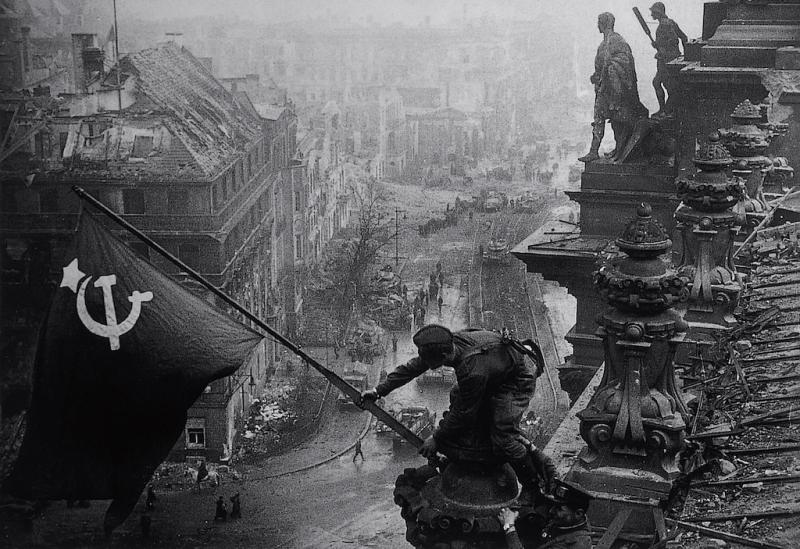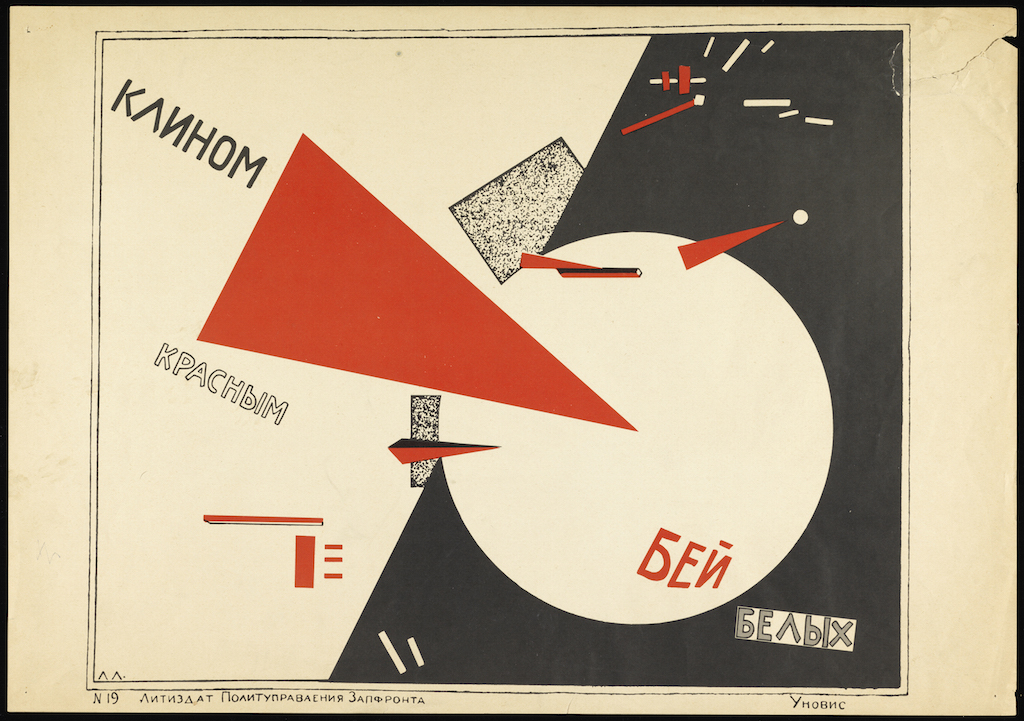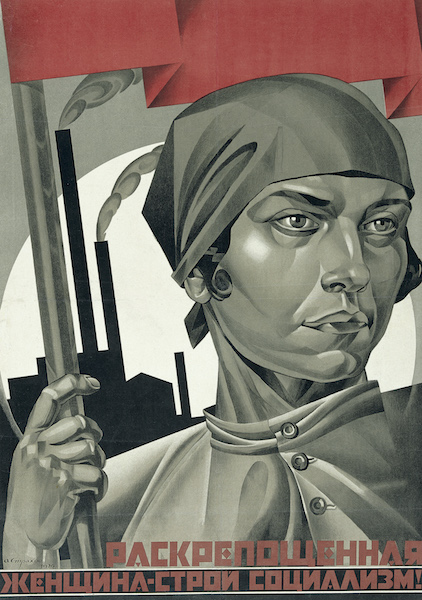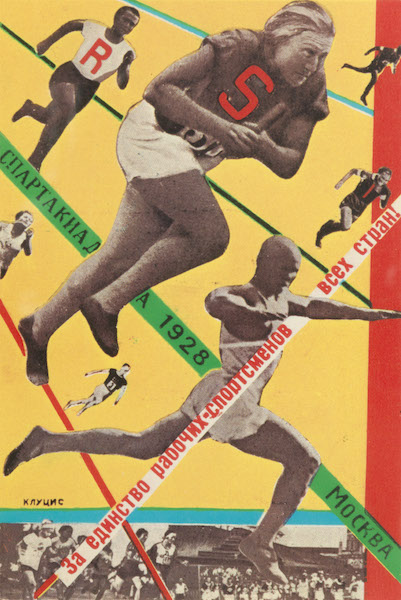Red Star Over Russia, Tate Modern review – fascinating history in a nutshell | reviews, news & interviews
Red Star Over Russia, Tate Modern review – fascinating history in a nutshell
Red Star Over Russia, Tate Modern review – fascinating history in a nutshell
A glimpse into the design, manipulation and dissemination of images in the USSR

Ilya and Emilia Kabakov’s Tate Modern exhibition features an installation made in 1985 of a Moscow bedsit, its walls lined with political posters.
Focusing on these same images, Red Star Over Russia: a Revolution in Visual Culture 1905-55 reveals the incredible range and versatility of the posters, pamphlets, postcards, magazines, books and banners designed to spread the word about the 1917 revolution and galvanise people into action.
This remarkable collection of ephemera was amassed over many years by graphic designer, Dave King, art editor of the Sunday Times Magazine from 1965 to 1975, who was deeply influenced by the power and simplicity of the images he collected.  Especially in the early years of the fledgling regime, artists played a key role by designing visuals clear enough to be understood by a diverse and largely illiterate population. They travelled on board the agitprop trains and ships that disseminated information the length and breadth of the new republic. These were furnished with printing presses so the artists could produce a constant stream of fresh material to augment the talks, films and plays being presented in transit.
Especially in the early years of the fledgling regime, artists played a key role by designing visuals clear enough to be understood by a diverse and largely illiterate population. They travelled on board the agitprop trains and ships that disseminated information the length and breadth of the new republic. These were furnished with printing presses so the artists could produce a constant stream of fresh material to augment the talks, films and plays being presented in transit.
The exhibition opens with a wall of posters. No style predominates; in Beat the Whites with the Red Wedge, 1920 (pictured above) El Lissitzky conveys his message with a red triangle piercing a white circle. In his 1926 poster Emancipated Woman: Build Socialism! (pictured below left) Adolf Strakhov silhouettes the chiselled features of a banner-wielding woman against a backdrop of factory chimneys that indicate her engagement in industrial production as well as politics.
 The two approaches of abstraction and realism continued to be used but realism gradually gained the upper hand just as the experimental layouts and photomontages of artists such as Gustav Klutsis (pictured below right: Moscow All Union Olympiad, 1928), Valentina Kulagena and Aleksandr Rodchenko gave way to more traditional approaches. In 1942 the Kukryniksy Collective translated the image of a red arrow piercing a white circle into a lightning bolt striking an umbrella. Hitler and Mussolini cower beneath the umbrella while three flags – the Union Jack, Stars and Stripes and Hammer and Sickle – join forces to form the penetrating dart.
The two approaches of abstraction and realism continued to be used but realism gradually gained the upper hand just as the experimental layouts and photomontages of artists such as Gustav Klutsis (pictured below right: Moscow All Union Olympiad, 1928), Valentina Kulagena and Aleksandr Rodchenko gave way to more traditional approaches. In 1942 the Kukryniksy Collective translated the image of a red arrow piercing a white circle into a lightning bolt striking an umbrella. Hitler and Mussolini cower beneath the umbrella while three flags – the Union Jack, Stars and Stripes and Hammer and Sickle – join forces to form the penetrating dart.
The headscarf-wearing peasant woman became a recurring motif. In the 1937 International Exhibition in Paris, Vera Mukhina crowned the Soviet pavilion with a monumental sculpture of a peasant woman twinned with a factory worker. They celebrate the union of industry and farming (he holds aloft a hammer, she a sickle) that drove the economy. In Nina Vatolina’s 1941 poster, the woman adopts a defiant stance against Fascism, but despite her red dress, she shows signs of anxiety rather than triumph.
 King also collected photographs, which played an important role in disseminating ideas. For dramatic effect, photographs were often enhanced or completely staged. Yevgeny Khaldei’s 1945 photograph of Red Army soldiers hoisting the Soviet flag over the bombed-out Reichstag (main picture), for instance, was actually staged after the event. The infamous practice of airbrushing people like Trotsky out of history is documented in several “before” and “after” prints. King also collected mugshots taken of political detainees, including Gustav Klutsis, before they were executed or sent to the gulag.
King also collected photographs, which played an important role in disseminating ideas. For dramatic effect, photographs were often enhanced or completely staged. Yevgeny Khaldei’s 1945 photograph of Red Army soldiers hoisting the Soviet flag over the bombed-out Reichstag (main picture), for instance, was actually staged after the event. The infamous practice of airbrushing people like Trotsky out of history is documented in several “before” and “after” prints. King also collected mugshots taken of political detainees, including Gustav Klutsis, before they were executed or sent to the gulag.
Divided into sections that make good historical and thematic sense, the exhibition provides a fascinating glimpse into the way that, over many decades, visual material was designed, manipulated and disseminated to encourage Soviet citizens to behave in ways that furthered the Communist cause.
- Red Star Over Russia: A Revolution in Visual Culture 1905-55 at Tate Modern until 18 February
- Read more visual arts reviews on theartsdesk
rating
Share this article
The future of Arts Journalism
You can stop theartsdesk.com closing!
We urgently need financing to survive. Our fundraising drive has thus far raised £49,000 but we need to reach £100,000 or we will be forced to close. Please contribute here: https://gofund.me/c3f6033d
And if you can forward this information to anyone who might assist, we’d be grateful.

Subscribe to theartsdesk.com
Thank you for continuing to read our work on theartsdesk.com. For unlimited access to every article in its entirety, including our archive of more than 15,000 pieces, we're asking for £5 per month or £40 per year. We feel it's a very good deal, and hope you do too.
To take a subscription now simply click here.
And if you're looking for that extra gift for a friend or family member, why not treat them to a theartsdesk.com gift subscription?
more Visual arts
 'We are bowled over!' Thank you for your messages of love and support
Much-appreciated words of commendation from readers and the cultural community
'We are bowled over!' Thank you for your messages of love and support
Much-appreciated words of commendation from readers and the cultural community
 Folkestone Triennial 2025 - landscape, seascape, art lovers' escape
Locally rooted festival brings home many but not all global concerns
Folkestone Triennial 2025 - landscape, seascape, art lovers' escape
Locally rooted festival brings home many but not all global concerns
 Sir Brian Clarke (1953-2025) - a personal tribute
Remembering an artist with a gift for the transcendent
Sir Brian Clarke (1953-2025) - a personal tribute
Remembering an artist with a gift for the transcendent
 Emily Kam Kngwarray, Tate Modern review - glimpses of another world
Pictures that are an affirmation of belonging
Emily Kam Kngwarray, Tate Modern review - glimpses of another world
Pictures that are an affirmation of belonging
 Kiefer / Van Gogh, Royal Academy review - a pairing of opposites
Small scale intensity meets large scale melodrama
Kiefer / Van Gogh, Royal Academy review - a pairing of opposites
Small scale intensity meets large scale melodrama
 Jenny Saville: The Anatomy of Painting, National Portrait Gallery review - a protégé losing her way
A brilliant painter in search of a worthwhile subject
Jenny Saville: The Anatomy of Painting, National Portrait Gallery review - a protégé losing her way
A brilliant painter in search of a worthwhile subject
 Abstract Erotic, Courtauld Gallery review - sculpture that is sensuous, funny and subversive
Testing the boundaries of good taste, and winning
Abstract Erotic, Courtauld Gallery review - sculpture that is sensuous, funny and subversive
Testing the boundaries of good taste, and winning
 Edward Burra, Tate Britain review - watercolour made mainstream
Social satire with a nasty bite
Edward Burra, Tate Britain review - watercolour made mainstream
Social satire with a nasty bite
 Ithell Colquhoun, Tate Britain review - revelations of a weird and wonderful world
Emanations from the unconscious
Ithell Colquhoun, Tate Britain review - revelations of a weird and wonderful world
Emanations from the unconscious
 Rachel Jones: Gated Canyons, Dulwich Picture Gallery review - teeth with a real bite
Mouths have never looked so good
Rachel Jones: Gated Canyons, Dulwich Picture Gallery review - teeth with a real bite
Mouths have never looked so good
 Yoshitomo Nara, Hayward Gallery review - sickeningly cute kids
How to make millions out of kitsch
Yoshitomo Nara, Hayward Gallery review - sickeningly cute kids
How to make millions out of kitsch
 Hamad Butt: Apprehensions, Whitechapel Gallery review - cool, calm and potentially lethal
The YBA who didn’t have time to become a household name
Hamad Butt: Apprehensions, Whitechapel Gallery review - cool, calm and potentially lethal
The YBA who didn’t have time to become a household name

Add comment